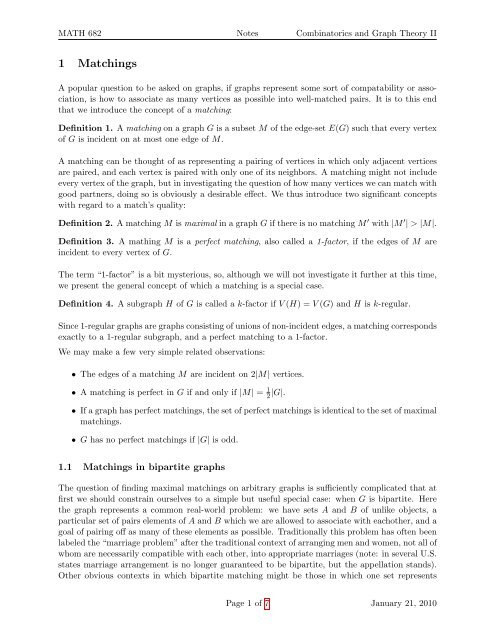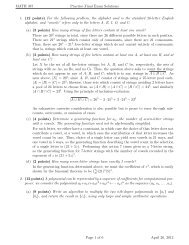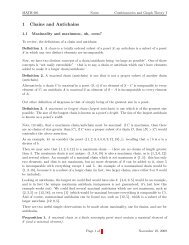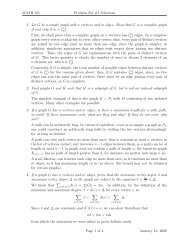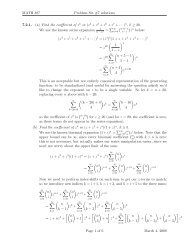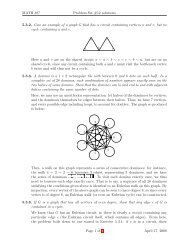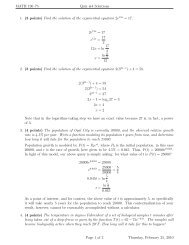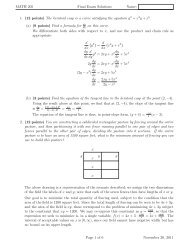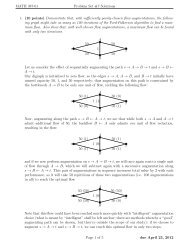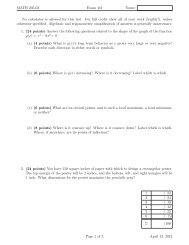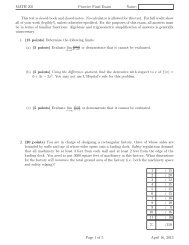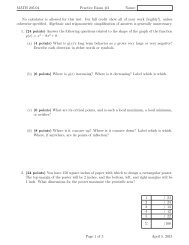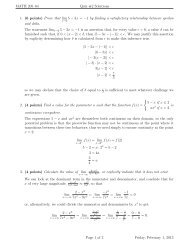Notes for 01/21
Notes for 01/21
Notes for 01/21
You also want an ePaper? Increase the reach of your titles
YUMPU automatically turns print PDFs into web optimized ePapers that Google loves.
MATH 682 <strong>Notes</strong> Combinatorics and Graph Theory II<br />
1 Matchings<br />
A popular question to be asked on graphs, if graphs represent some sort of compatability or association,<br />
is how to associate as many vertices as possible into well-matched pairs. It is to this end<br />
that we introduce the concept of a matching:<br />
Definition 1. A matching on a graph G is a subset M of the edge-set E(G) such that every vertex<br />
of G is incident on at most one edge of M.<br />
A matching can be thought of as representing a pairing of vertices in which only adjacent vertices<br />
are paired, and each vertex is paired with only one of its neighbors. A matching might not include<br />
every vertex of the graph, but in investigating the question of how many vertices we can match with<br />
good partners, doing so is obviously a desirable effect. We thus introduce two significant concepts<br />
with regard to a match’s quality:<br />
Definition 2. A matching M is maximal in a graph G if there is no matching M ′ with |M ′ | > |M|.<br />
Definition 3. A mathing M is a perfect matching, also called a 1-factor, if the edges of M are<br />
incident to every vertex of G.<br />
The term “1-factor” is a bit mysterious, so, although we will not investigate it further at this time,<br />
we present the general concept of which a matching is a special case.<br />
Definition 4. A subgraph H of G is called a k-factor if V (H) = V (G) and H is k-regular.<br />
Since 1-regular graphs are graphs consisting of unions of non-incident edges, a matching corresponds<br />
exactly to a 1-regular subgraph, and a perfect matching to a 1-factor.<br />
We may make a few very simple related observations:<br />
• The edges of a matching M are incident on 2|M| vertices.<br />
• A matching is perfect in G if and only if |M| = 1 2 |G|.<br />
• If a graph has perfect matchings, the set of perfect matchings is identical to the set of maximal<br />
matchings.<br />
• G has no perfect matchings if |G| is odd.<br />
1.1 Matchings in bipartite graphs<br />
The question of finding maximal matchings on arbitrary graphs is sufficiently complicated that at<br />
first we should constrain ourselves to a simple but useful special case: when G is bipartite. Here<br />
the graph represents a common real-world problem: we have sets A and B of unlike objects, a<br />
particular set of pairs elements of A and B which we are allowed to associate with eachother, and a<br />
goal of pairing off as many of these elements as possible. Traditionally this problem has often been<br />
labeled the “marriage problem” after the traditional context of arranging men and women, not all of<br />
whom are necessarily compatible with each other, into appropriate marriages (note: in several U.S.<br />
states marriage arrangement is no longer guaranteed to be bipartite, but the appellation stands).<br />
Other obvious contexts in which bipartite matching might be those in which one set represents<br />
Page 1 of 7 January <strong>21</strong>, 2<strong>01</strong>0
MATH 682 <strong>Notes</strong> Combinatorics and Graph Theory II<br />
jobs, the other prospective workers, and the edges qualifications to do the job, or those in which<br />
one set represents classes at a certain time, the other classrooms, and the edges sufficient capacity<br />
to contain the class.<br />
So, in considering matchings in a bipartite graph G, it will be clear that each edge of a matching<br />
M will be incident to one vertex in A and one vertex in B, and thus a matching can only be perfect<br />
if |A| = |B|. A somewhat weaker condition than absolute perfection is to guarantee that at least<br />
one set is matched.<br />
Definition 5. A matching M in a bipartite graph with parts A and B is called A-perfect if M is<br />
incident on every vertex of A.<br />
We can note easily, since each edge in M is incident on a distinct vertex if A, that M is A-perfect<br />
if and only if |M| = |A|. Thence we can easily determine that an A-perfect matching is maximal,<br />
and that a matching is perfect if and only if it is A-perfect and |A| = |B|. Thus, investigating<br />
A-perfection is sufficient to discover when a matching is perfect.<br />
Clearly there are graphs in which maximal matchings are not A-perfect. Suppose v ∈ A has no<br />
neighbors (i.e. degree zero). Then, regardless of what edges are in a matching M, none of them are<br />
incident on v, so M cannot be A-perfect. Investigating further, we find a similar if slightly more<br />
difficult to illuminate situation if there are v 1 and v 2 in A both of whose only neighbor is some u in<br />
B: No matching can include both the edges {v 1 , u} and {v 2 , u}, since those edges are both incident<br />
on the same vertex, so every matching M either lacks an edge incident on v 1 or an edge incident<br />
on v 2 . Generalizing this argument:<br />
Definition 6. The neighborhood N(S) of a vertex-set S is the set of all vertices adjacent to some<br />
vertex of S. N({v}) may be written as N(v).<br />
Proposition 1. For a bipartite graph G = (A, B), if G has an A-perfect matching, then <strong>for</strong> every<br />
S ⊆ A, |N(S)| ≥ |S|.<br />
Proof. For an arbitrary S, let us label its vertices S = {a 1 , a 2 , a 3 , . . . , a n }. Let M be an A-perfect<br />
matching in G. Then, <strong>for</strong> each i, M contains {a i , b i } <strong>for</strong> some b i ∈ B. Since each edge must<br />
have distinct endpoints, all the b i are distinct, and since each b i is adjacent to a i ∈ A, it follows by<br />
definition that b i ∈ N(S). Thus {b 1 , b 2 , . . . , b n } is an n-element subset of N(S), so |N(S)| ≥ |S|.<br />
We have determined a fairly strong necessary condition <strong>for</strong> a graph to have an A-perfect matching;<br />
it may not come as a surprise, then, that this condition is in fact sufficient as well. However, we will<br />
need several other tools to prove it. We will start by investigating a relationship between matchings<br />
and a somewhat dual concept of a vertex cover.<br />
Definition 7. A subset S of the vertex-set of G is called a vertex cover if every edge of G is incident<br />
on a vertex of S.<br />
Proposition 2. If M is a matching in G and S is a vertex cover of G, then |M| ≤ |S|.<br />
Proof. Denote M = {{u 1 , v 1 }, {u 2 , v 2 }, {u 3 , v 3 }, . . . , {u n , v n }}. By the definition of a matching all<br />
of the vertices u 1 , u 2 , . . . , u n , v 1 , v 2 , . . . , v n are distinct. Since S is a vertex-cover of G, each edge<br />
{u i , v i } must have an endpoint in S, so S contains at least one of u i , v i <strong>for</strong> each i. Since i ranges<br />
from 1 to n, this guarantees n distinct elements of S, so |S| ≥ |M|.<br />
Page 2 of 7 January <strong>21</strong>, 2<strong>01</strong>0
MATH 682 <strong>Notes</strong> Combinatorics and Graph Theory II<br />
Since every vertex cover is at least as large as every matching, finding a vertex cover and a matching<br />
of equal size would be a strong and useful fact: the matching so found must be maximal, and the<br />
vertex-cover minimal. It is always, in fact, possible to do so in a bipartite graph:<br />
Theorem 1 (König-Egerváry, ’31). A bipartite graph G contains a matching M and set-cover S<br />
such that |M| = |S|.<br />
Proof. Let M = {{a 1 , b 1 }, . . . , {a n , b n }} be a maximal matching in G. We shall explicitly construct<br />
a set-cover S guaranteed to be equal in size to M by selecting one endpoint of each edge.<br />
A path P = v 1 ∼ v 2 ∼ v 3 ∼ · · · ∼ v k in G is denoted as alternating with respect to M if v 1 ∈ A,<br />
v i is not incident on any edge in M, {v i , v i+1 } /∈ M <strong>for</strong> all odd i, and {v i , v i+1 } ∈ M <strong>for</strong> all even<br />
i; that is to say, an alternating path is one beginning at a vertex of A not matched by M, and<br />
following alternatingly edges not in M and in M.<br />
For every edge {a i , b i } in M, select b i as an element of S if there is an alternating path P i ending<br />
in b i , and select a i otherwise. By construction, |S| = |M|; we shall show furthermore that every<br />
edge in G is incident on some vertex of S, so S is a vertex cover.<br />
It is easy to show that every edge in M is incident on a vertex of S, since S was constructed by<br />
selecting an endpoint of every edge in M. Let us consider an edge {a, b} /∈ M. Since M is maximal,<br />
M ∪ {{a, b}} can not be a matching, so {a, b} must share an endpoint with some edge {a i , b i }; i.e.,<br />
either a i = a or b i = b <strong>for</strong> some i.<br />
If a i ≠ a <strong>for</strong> all i and there is a b j = b, then a is not incident on any edge in M, so {a, b j } is<br />
an alternating path in G with respect to M, so by construction, b j ∈ S, so {a, b} is incident on a<br />
vertex of S (specifically, incident on b j ).<br />
On the other hand, if a i = a <strong>for</strong> some i, there are two possibilities: either a i ∈ S, in which case {a, b}<br />
is clearly covered by S, or b i ∈ S, which tells us that b i is the endpoint of some alternating path<br />
P i given by v 1 ∼ v 2 ∼ · · · ∼ v k−1 ∼ v k = b i . Now we shall show that b is also the endpoint of some<br />
alternating path: if b = v j <strong>for</strong> some j, we could truncate the above path to v 1 ∼ v 2 ∼ · · · v j = b i .<br />
If, on the other hand, b i does not appear on the path, then v 1 ∼ · · · v k = b i ∼ a i = a ∼ b is<br />
an alternating path. Thus, either b is incident on some edge in M, in which case b ∈ S by the<br />
construction of S, yielding a vertex in S incident to {a, b}, or, b is not incident on any edge in S.<br />
We shall show that this last situation contradicts the maximality of S.<br />
If b is not incident on any edge of S, we may select different edges appearing in the above alternating<br />
path from v 1 to b while preserving M as a matching. Recall that by the definition of alternation,<br />
v 1 is some vertex in A not incident on any element of M, every edge {v i , v i+1 } <strong>for</strong> even i is in M,<br />
and every edge {v i , v i+1 } <strong>for</strong> odd i is not in M; furthermore, since v j = b ∈ B, it is necessary that<br />
j is even. We shall construct a new matching by replacing which edges of the alternating path are<br />
in M:<br />
M ′ = M − {{v 2 , v 3 }, {v 4 , v 5 }, . . . , {v j−2 , v j−1 } ∪ {{v 1 , v 2 }, {v 3 , v 4 }, . . . , {v j−1 , v j }<br />
Note that M ′ is a matching, since it has the same incidence upon every vertex of G as M did except<br />
<strong>for</strong> the vertices v 1 and v j , which it has exactly one edge incident upon instead of zero. Furthermore,<br />
|M ′ | = |M| + 1, so |M| is not maximal.<br />
We have thus shown that, <strong>for</strong> every edge in G, some vertex of our constructed set S is incident to<br />
that edge, so S is a vertex cover.<br />
Page 3 of 7 January <strong>21</strong>, 2<strong>01</strong>0
MATH 682 <strong>Notes</strong> Combinatorics and Graph Theory II<br />
This is a pretty messy and long proof, but it is actually the standard proof, since it contains<br />
within it the seeds of a matching algorithm based on selecting an arbitrary matching, selecting an<br />
associated set S and seeing which of the above failures-of-maximality occur. There is, however,<br />
<strong>for</strong> fans of brevity, and <strong>for</strong> those who like clever conenctions among different branches of the same<br />
discipling, a very clever proof.<br />
The seed of this idea is that we have in fact proved a structurally similar result be<strong>for</strong>e! We have two<br />
structures, somewhat dual to eachother, one of which is consistently at least as large as the other.<br />
Our unusual result is that these structures are sometimes equivalent in size. If we replace “bipartite<br />
graph” with “poset”, “vertex cover” with “chain partition”, and “matching” with “antichain”, we<br />
have Dilworth’s Theorem!<br />
Alternative proof. For bipartite G = (A, B) with |G| = n, let us define the poset (V (G), ≼) by the<br />
relation a ≼ b iff a ∈ A, B ∈ B, and a ∼ b. Visually speaking, this is essentially rotating our graph<br />
90 degrees from a conventional bipartite representation and calling the result a Hasse diagram.<br />
By Dilworth’s Theorem, this poset has an antichain A and partition into chains C such that |A| =<br />
|C| = k <strong>for</strong> some k. This poset obviously has height of no more than 2, since every element of<br />
A is minimal and every element of B is maximal. Thus, the elements of C are of two types:<br />
single vertices in G (chains of size 1) and edges in G (chains of size 2). Let us denote C =<br />
{C 1 , . . . , C l , C l+1 , · · · , C k }, where C 1 , . . . , C l have size 2, and C l+1 , . . . , C k have size 1. Since these<br />
chains partition the poset, we know that ∑ k<br />
i=1 |C i| = |G|, which can be simplified to 2l+(k−l) = n<br />
or l = n − k. Since C is a partition of V (G), the chains are all vertex-disjoint, so in particular<br />
{C 1 , . . . , C l } is a vertex-disjoint collection of edges; that is to say, a matching of size n − k.<br />
Now we shall derive from A a vertex cover of size n − k to prove the König-Egerváry Theorem.<br />
Since A is an antichain, no two elements of A are comparable, which means by the construction<br />
of our poset that in G, there are no edges between elements of A (i.e., in graph parlance, A is<br />
an independent set). Thus, every single edge in G is incident on at most one member of A, and<br />
thus is incident on at least one member of V (G) − A. Thus V (G) − A is a vertex cover of G, and<br />
|V (G) − A| = n − k.<br />
Incidentally, it is also possible to prove Dilworth’s Theorem from König-Egerváry: <strong>for</strong> a poset<br />
(S, ≼), associate each s ∈ S with two vertices a s and b s of a bipartite graph G, and let a s ∼ b t iff<br />
s ≼ t. Then we reverse the process in the proof above: take the complement of a vertex cover to<br />
get an antichain, and kludge edges from a matching together to build a system of disjoint chains.<br />
This theorem tells us a lot about maximal matchings, but not when those matchings are perfect.<br />
However, it is a simple derivation from König-Egerváry to a perfection criterion:<br />
Theorem 2 (Hall ’35). For a bipartite graph G = (A, B), G has an A-perfect matching, if and<br />
only if <strong>for</strong> every S ⊆ A, |N(S)| ≥ |S|.<br />
Proof. The necessity of this condition was established in Proposition 1; here we shall show that the<br />
given condition is also sufficient.<br />
Let G be such that <strong>for</strong> all S ⊆ A, |N(S)| ≥ |S|. Clearly A is a vertex cover of G; we shall show that it<br />
is the smallest such. Suppose |S| < |A| and S is a vertex cover of A. Let S A = S∩A and S B = S∩B.<br />
Then, |S A |+|S B | = |S| < |A|. Let T = A−S A ; note that |T | = |A|−|S A | = |A|−(|S|−|S B |) > |S B |.<br />
By the condition given in the theorem, |N(T )| > |T |, so |N(T )| > |S B |. Thus, there is necessarily<br />
at least one vertex in T adjacent to a vertex not in S B . The edge between these vertices is clearly<br />
Page 4 of 7 January <strong>21</strong>, 2<strong>01</strong>0
MATH 682 <strong>Notes</strong> Combinatorics and Graph Theory II<br />
not covered: the vertex on the A end of the edge is in T , and by definition thus not in S A , and on<br />
the B end of the edge the vertex is shown not to be in S B . Thus, there is at least one edge in G<br />
not covered by this set S.<br />
Thus, there is no vertex cover of size less than |A|, and there is clearly a vertex cover of size |A|, so<br />
|A| is the minimum size of a vertex cover in G. By König-Egerváry, it follows that the maximum<br />
size of a matching in G is |A|; such a matching is necessarily A-perfect.<br />
This proof of Hall’s Theorem is not actually traditional. A more illuminating if less elegant proof<br />
results from algorithmically developing a maximal matching.<br />
Constructive proof. Suppose M is a matching which is not A-perfect. We will show that, from the<br />
Hall criterion, it is possible to build a larger matching.<br />
Let a 0 be a vertex in A unmatched by M; the Hall Criterion guarantees that a 0 has at least one<br />
neighbor, which we shall call b 1 . If b 1 is unmatched, then the edge {a 0 , b 1 } is a clear improvement<br />
on M. Otherwise, let a 1 be the vertex matched with b 1 by M. Now, since |N({a 0 , a 1 })| ≥ 2,<br />
there must be some b 2 which is a neighbor of either a 0 or a 1 . If b 2 is matched, we can include<br />
a 3 and therefrom find a b 4 , and so <strong>for</strong>th. We can thus build a sequence of distinct vertices<br />
a 0 , b 1 , a 1 , b 2 , a 2 , . . . , b k−1 , a k−1 , b k such that:<br />
• a 0 is unmatched.<br />
• Each b i ∈ N({a 0 , a 1 , . . . , a i−1 }).<br />
• Each {a i , b i } ∈ M.<br />
• b k is unmatched.<br />
The last of these conditions arises from the only situation in which a b i cannot give us some a i to<br />
continue the sequence.<br />
What we shall now do is construct an alternating path from b k to a 0 using these properties, and since<br />
b k and a 0 are unmatched, toggling membership in M over this path will make a larger matching.<br />
Starting from b k , we know, since b k ∈ N({a 0 , . . . , a k−1 }), that some a i1 is b k ’s neighbor <strong>for</strong> i 1 < k.<br />
Then by the construction {a i1 , b i1 } ∈ M, and we repeat the above <strong>for</strong> b i1 : b i1 ∈ N({a 0 , . . . , a i1 −1}),<br />
so b i1 is adjacent to some a i2 with i 2 < i 1 . We continue onwards until it is impossible to progress<br />
further, which will happen only when either some b i has no neighbor with smaller index (which is<br />
impossible by our construction) or there is some a i with no matched partner, which only occurs at<br />
a 0 . Thus there is an alternating path<br />
b k ∼ a i1 ∼ b i1 ∼ a i2 ∼ b i2 ∼ · · · ∼ a il ∼ b il ∼ a 0<br />
And we can thus improve the matching M by replacing the l edges {a ij , b ij } with the l + 1 edges<br />
{b k , a i1 }, {b i1 , a i2 }, {b i2 , a i3 }, · · · , {b il , a 0 }.<br />
Since every matching with an unmatched vertex in A can be made larger, it follows that the largest<br />
matching has no unmatched vertices in A, and is thus A-perfect.<br />
This proof is in some ways superior to the König-Egerváry argument, because it contains the seeds<br />
of an algorthm <strong>for</strong> building an A-perfect (and thus actually perfect, where possible) matching. Our<br />
algorithm is as follows:<br />
Page 5 of 7 January <strong>21</strong>, 2<strong>01</strong>0
MATH 682 <strong>Notes</strong> Combinatorics and Graph Theory II<br />
1. Pick a matching M (you can start with the empty matching, or a greedily-constructed matching,<br />
both of which are pretty easy.<br />
2. If every vertex of A is matched by M, we have an A-perfect matching and are done. Otherwise,<br />
let a 0 be the unmatched vertex, and let i be 1.<br />
3. If there is a vertex adjacent to {a 0 , . . . , a i−1 } not already selected as some b k , call it b i .<br />
Otherwise, our graph fails the Hall criterion and has no A-perfect matching.<br />
4. If b i is in our matching, let a i be the vertex matched with it, and increment i and return to<br />
step 3. Otherwise, continue to step 5.<br />
5. Let u 1 = b i , and let j = 1.<br />
6. Let v j be the element of {a 0 , . . . , a i−1 } of lowest index which is adjacent to u j .<br />
7. If v j = a 0 , then continue to the next step. Otherwise, let u j+1 be the vertex matched with<br />
v j in the matching M, increment j, and return to step 6.<br />
8. Remove all edges {v 1 , u 2 }, {v 2 , u 3 }, . . . , {v j−1 , u j } from M, and put the edges {u 1 , v 1 }, {u 2 , v 2 }, . . . , {u j , v j }<br />
in M.<br />
9. Forget what all these variables mean, and return to step 2.<br />
OK, this gets us to a good place as regards matchings in bipartite graphs: we have an algorithm<br />
<strong>for</strong> constructing perfect matchings when they exist (and a moderate tweak of this algorithm can<br />
even find maximal matchings in graphs that don’t meet the Hall criterion). Now we move on to a<br />
harder problem.<br />
1.2 Matchings in non-bipartite graphs<br />
This is a pairing problem <strong>for</strong> not-necessarily-unlike items: one traditional name <strong>for</strong> it is “the roommate<br />
problem”, since unlike <strong>for</strong> job assignments or heterosexual marriage, roommate suitability is<br />
compatability among a single group with no intrinsic bipartition.<br />
Up front, we can work out a few simple facts:<br />
• If G has an odd number of vertices, it has no perfect matching.<br />
• If G has any isolated vertices, it has no perfect matching.<br />
• G has a perfect matching if and only if each of its components has a perfect matching.<br />
The first and second of these observations can actually be united by way of the third to the<br />
observation that if G has any component with an odd number of vertices, then G has no perfect<br />
matching.<br />
In fact, using the same arguments we used to show necessity of the Hall condition on bipartite<br />
graphs, we can find a fairly strong necessary condition <strong>for</strong> a graph to have a perfect matching.<br />
Note that the below condition includes our above observation when S = ∅.<br />
Proposition 3. If there is a set S such that G − S has more than |S| components with an odd<br />
number of vertices, then G has no perfect matching.<br />
Page 6 of 7 January <strong>21</strong>, 2<strong>01</strong>0
MATH 682 <strong>Notes</strong> Combinatorics and Graph Theory II<br />
Proof. Let M be a matching on G and let S = {v 1 , v 2 , . . . , v k }. Now consider the restriction M ′ of<br />
M to G − S, so any edges incident on the v i no longer appear in M ′ . Given that G − S has odd<br />
components C 1 , C 2 , . . . , C k+1 (and possibly more), we know by our above observation that there is<br />
at least vertex u i in each C i which is unmatched by M ′ . Now, we know that M consists only of<br />
the edges in M ′ together with at most one edge incident on each v i , so M contains at most k edges<br />
not in M ′ ; however, there are at least 2k + 1 vertices of G which were unmatched by M ′ (all the<br />
u i and v i ), so M does not match every vertex in G.<br />
In fact, much as Hall’s Marriage Theorem showed that the analogous condition was sufficient in<br />
bipartite graphs, so will we see that this condition is sufficient <strong>for</strong> non-bipartite graphs.<br />
Page 7 of 7 January <strong>21</strong>, 2<strong>01</strong>0


